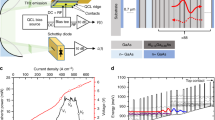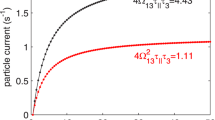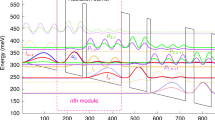Abstract
Quantum cascade lasers1 are promising mid-infrared semiconductor light sources for molecular detection in applications such as environmental sensing or medical diagnostics. For such applications, researchers have been striving to improve device performance2. Recently, improvements in wall plug efficiency have been pursued with a view to realizing compact, portable, power-efficient and high-power quantum cascade laser systems3,4. However, advances have largely been incremental, and the basic quantum design has remained unchanged for many years, with the wall plug efficiency yet to reach above 35%. A crucial factor in quantum cascade laser performance is the efficient transport of electrons into the laser active regions. We recently theoretically described this transport process as limited by the interface-roughness-induced detuning of resonant tunnelling5. Here, we report that an ‘ultrastrong coupling’ design strategy overcomes this limiting factor and leads to the experimental realization of quantum cascade lasers with 40–50% wall plug efficiency when operated in pulsed mode at temperatures of 160 K or lower.
This is a preview of subscription content, access via your institution
Access options
Subscribe to this journal
Receive 12 print issues and online access
$209.00 per year
only $17.42 per issue
Buy this article
- Purchase on Springer Link
- Instant access to full article PDF
Prices may be subject to local taxes which are calculated during checkout





Similar content being viewed by others
References
Faist, J. et al. Quantum cascade laser. Science 264, 553–556 (1994).
Gmachl, C., Capasso, F., Sivco, D. L. & Cho, A. Y. Recent progress in quantum cascade lasers and applications. Rep. Prog. Phys. 64, 1533–1601 (2001).
Wang, Q. J. et al. High performance quantum cascade lasers based on three-phonon-resonance design. Appl. Phys. Lett. 94, 011103 (2009).
Bai, Y., Slivken, S., Darvish, S. & Razeghi, M. Room temperature continuous wave operation of quantum cascade lasers with 12.5% wall plug efficiency. Appl. Phys. Lett. 93, 021103 (2008).
Khurgin, J. B. et al. Role of interface roughness in the transport and lasing characteristics of quantum-cascade lasers. Appl. Phys. Lett. 94, 091101 (2009).
Sirtori, C. et al. Resonant tunneling in quantum cascade lasers. IEEE J. Quantum Electron. 34, 1722–1729 (1998).
Faist, J. Wallplug efficiency of quantum cascade lasers: critical parameters and fundamental limits. Appl. Phys. Lett. 90, 253512 (2007).
Offermans, P. et al. Digital alloy interface grading of an InAlAs/InGaAs quantum cascade laser structure studied by cross-sectional scanning tunneling microscopy. Appl. Phys. Lett. 83, 4131–4133 (2003).
Faist, J. et al. Bound-to-continuum and two-phonon resonance quantum-cascade lasers for high duty cycle, high-temperature operation. IEEE J. Quantum Electron. 38, 533–546 (2002).
Gresch, T., Giovannini, M., Hoyer, N. & Faist, J. Quantum cascade lasers with large optical waveguides. IEEE Photon. Tech. Lett. 18, 544–546 (2006).
Acknowledgements
The authors would like to acknowledge the collaboration with J. Meyer and his team at the Naval Research Laboratory, Washington, DC. This work is supported in part by the Mid-InfraRed Technologies for Health and the Environment (MIRTHE) Research Center (National Science Foundation—Engineering Research Centers) and the Defense Advanced Research Projects Agency—Efficient Mid-Wave Infrared Lasers Program.
Author information
Authors and Affiliations
Contributions
P.Q.L. carried out the design, fabricated the devices, performed the measurements and analysed the data. A.J.H. and M.D.E. contributed to the measurements and data analyses. K.J.F. developed the design tools. J.B.K. and Y.D. proposed the idea and carried out the theoretical calculations. X.W. conducted the MOCVD growth of the samples. J.-Y.F. contributed to the device fabrication. C.F.G. supervised the whole project and, together with P.Q.L., prepared the manuscript.
Corresponding author
Ethics declarations
Competing interests
The authors declare no competing financial interests.
Supplementary information
Rights and permissions
About this article
Cite this article
Liu, P., Hoffman, A., Escarra, M. et al. Highly power-efficient quantum cascade lasers. Nature Photon 4, 95–98 (2010). https://doi.org/10.1038/nphoton.2009.262
Received:
Accepted:
Published:
Issue Date:
DOI: https://doi.org/10.1038/nphoton.2009.262
This article is cited by
-
Predicting early failure of quantum cascade lasers during accelerated burn-in testing using machine learning
Scientific Reports (2022)
-
Hybrid Plasmonic SOI Ring Resonator for Bulk and Affinity Bio - sensing Applications
Silicon (2022)
-
Quantum cascade lasers grown on silicon
Scientific Reports (2018)
-
Investigation of Germanium-Loaded Slot Waveguides for Mid-Infrared Third Harmonic Generation
Plasmonics (2018)
-
A robust and tuneable mid-infrared optical switch enabled by bulk Dirac fermions
Nature Communications (2017)



